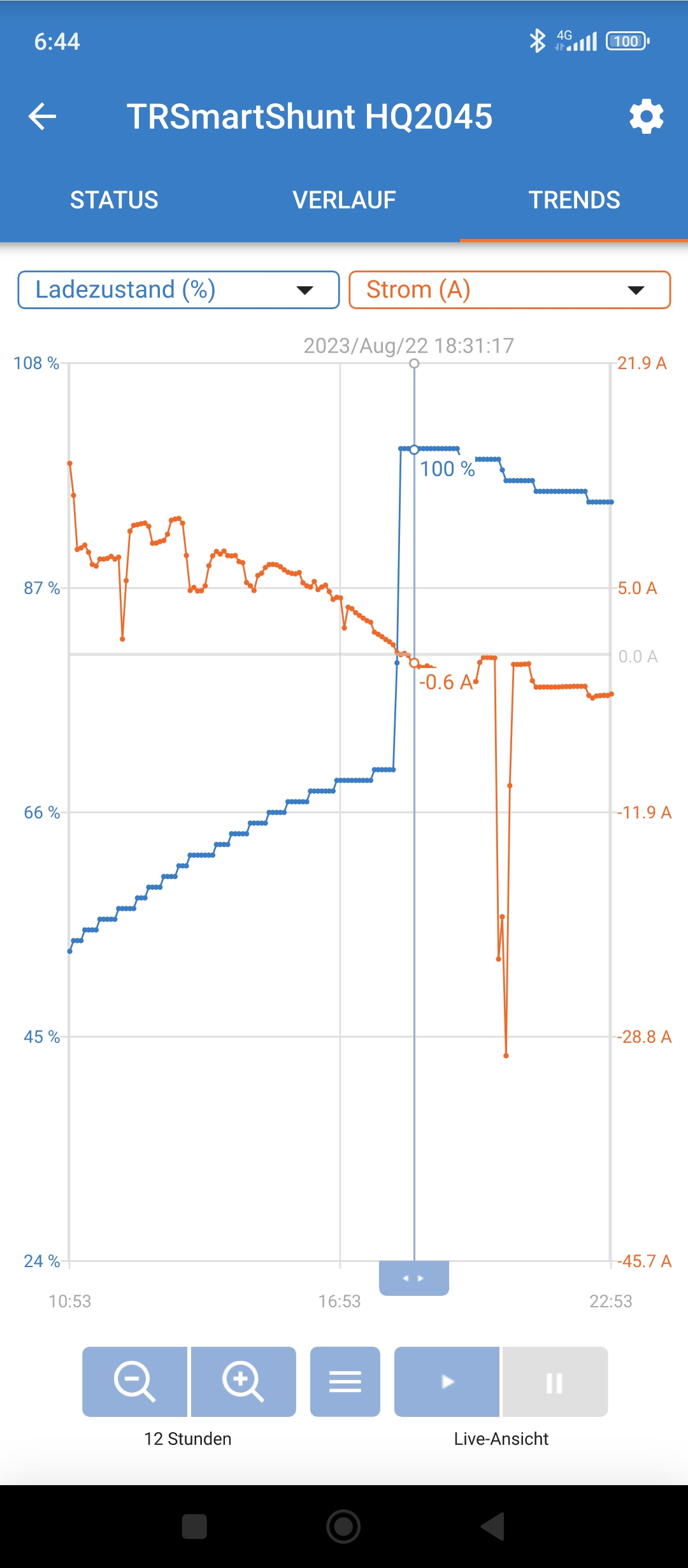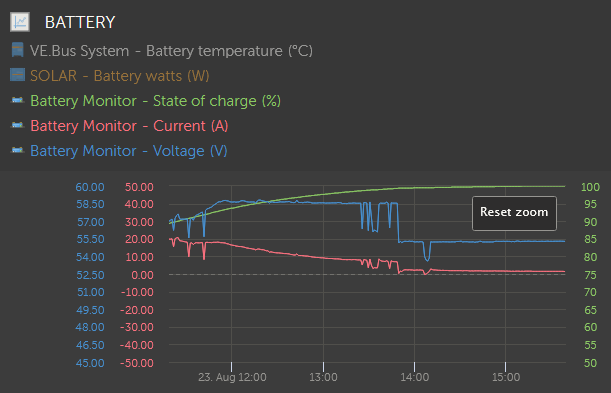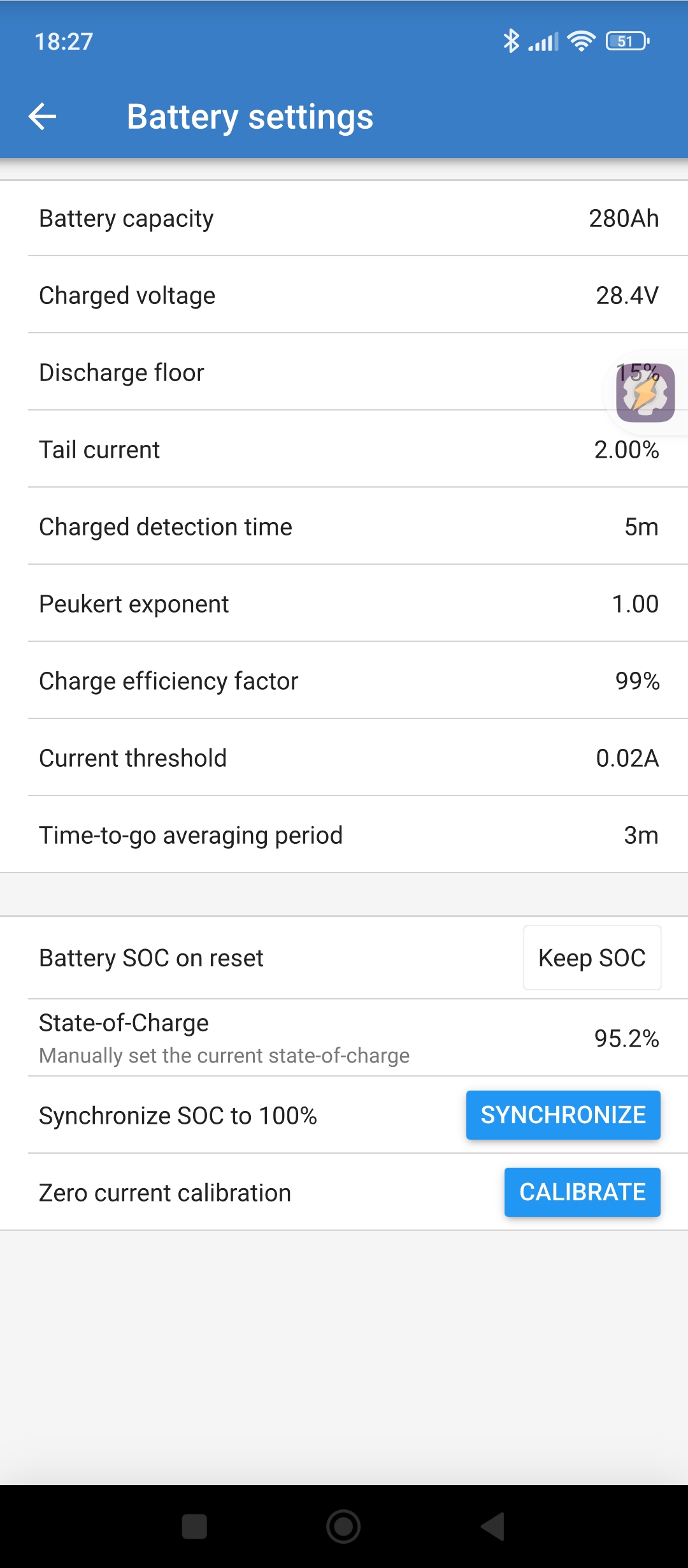 Could you please check with support
Could you please check with support
I am confused about soc 100%
Smart shunt
See screenshots
Wondering how jump from 70 to 100 without any load coming in can be explained?
Thanks
 Could you please check with support
Could you please check with support
I am confused about soc 100%
Smart shunt
See screenshots
Wondering how jump from 70 to 100 without any load coming in can be explained?
Thanks
Is the SmartShunt set to get to 100% after a reset?
There could be loose/corroded contact (for instance in the fuse holder) and combined with that setting , it would explain the jump to 100%.
If that setting is set to 100%, change it to "Clear". In case of a reset, SOC will show -- until a full charge.
Possibly just a false sync. This commonly happens on a tapering charge when Charged Voltage is set too low and/or Detection Time is too short. And of course it's in the manual.. https://www.victronenergy.com/media/pg/SmartShunt/en/all-features-and-settings.html#UUID-37b15df6-8521-aa94-3dfd-7f1d92e7f6f4
Set you charge detection time too 40 min and the charge detection voltage to 14V (AGM). If you read the manual it states that if you use the smart shut with solar you need to increase this numbers accordingly
Manual:
10.3.11. Synchronisation issues
If the battery monitor does not synchronise automatically, one possibility could be that the battery never reaches a fully charged state. Fully charge the battery and see if the state of charge eventually indicates 100%.
Another possibility is that the charged voltage setting [22] should be lowered and/or the tail current setting [23] should be increased.
It is also possible that the battery monitor synchronises too early. This can happen in solar systems or in systems that have fluctuating charge currents. If this is the case change the following settings:
• Increase the “charged voltage [22]" to slightly below the absorption charge voltage. For example: 14.2V in case of 14.4V absorption voltage (for a 12V battery).
• Increase the “charged detection time [23]” and/or decrease the "tail current [23]" to prevent an early reset due to passing clouds.
I'm sorry, but 40 min is way too long. This set Time is to allow for sluggish Pb batts to settle back on their V when charge may be interrupted by cloud, etc. The default 3 min is a bit short for me, but 5 min is enough. Waiting 40 min while those conditions remain satisfied isn't really workable. My system would be in Float by then anyway, and still not quite at 100%, so I sync using a V and Tail % that's appropriate there. I change it seasonally, winter is 13.5V and 0.7%, summer 13.3V and 0.6%. (48V equiv).
These figures are for my batts, not necessarily suited to all.
So what results weren't you happy with?
With respect, you posted your settings elsewhere. You use default Efficiency and Peukert figures, which would likely give an earlier than warranted rise to 100% SOC anyway. And the default 4% Tail would even beat that in.
This is mine today.. A 4% Tail/5min/14V would have synced ~13:05 at 97.8%. A 40min time would have put that off into the cloud dips and wouldn't have happened at all. It eventually synced ~15:00, the 'natural' rising SOC was between 99.9 and 100.0%. Sure my settings aren't that good every day, but I usually get within 0.3% natural vs forced sync.
A 4% Tail/5min/14V would have synced ~13:05 at 97.8%. A 40min time would have put that off into the cloud dips and wouldn't have happened at all. It eventually synced ~15:00, the 'natural' rising SOC was between 99.9 and 100.0%. Sure my settings aren't that good every day, but I usually get within 0.3% natural vs forced sync.
I checked a lot with shortertimes and I still had the SOC jumping. This was what I was not happy with.
In this thread is nowhere specified if we're talking about Lithium or AGM. My input was to share my experience with AGM systems.
My fridge turns on every 10-15 min an then runs for 10 minutes. If I set my charge detection time to short the shunt is picking up on my fridge interval and gives me a 100% SOC too early. I do not have lots of solar therefore I easily drop below any given tail current.
I think we're not comparing apples with apples. For small systems in camper vans or so, my settings work best for me. Yes maybe I can reduce peukert.
Maybe I should have asked Riker1 girt more about his application and battery before giving advice…that’s true.
Can’t show you my graphs I’m implementing a cerbo soon to better monitor it
Sure the systems are different. Mine's on a liveaboard boat, fla batts, and and all sorts of loads. But the principles don't really change. In your case(s) I'd suggest your 'jumps' are because your Tail is too high and sync is premature with short times set. So you've worked around it with a delay.
Like I use an mppt Tail to end Absorb. That's in Amps, but equates to 3% and about 99.0% SOC for me. So I'm not really interested in syncing before that with a 4% Tail. If Victron ever added an option to sync to 99.0% at 3% Tail, then I'd jump right into that.
I chase accuracy if I can. And just adding a delay to a decision doesn't fit so well with me.
All with respect. Thanks for the discussion point. :)
Hi
I understood that voltage setting is not a good indicator for soc on lifepo4 systems
I expected the shunt not sync by voltage but by Ah used and charged
Reading the AH is only a convenient metering device made for our benefit, but voltage is absolute, regardless of anything else.
I expected the shunt not sync by voltage but by Ah used and charged
Synchronization is a forced jump to 100%. It is always based on voltage (and time + tail current).
The SOC can get to 100% just by counting the Ah into the battery.
Hi
Traveling in Morocco without having internet, but sun
Settings are:

With those settings I do not think it synchronized too soon.
On the other hand, your SmartShunt is set to "Keep SOC" on reset, so it is not because a brief disconnect.
Change current threshold to the default 0.10A.
What is the Absorption voltage from your charger (MPPT and/or inverter - whatever you use to charge the battery)?
Hi
I try to control charging via BMS.
Over voltage protection, this is shutting down charging.
I want the battery not always full but keep it at 80%
Thought this is less stress for battery
Does this make sense?
The BMS shutting the door on the current means it will sync because the shunt doesn't know what's happening there. You have it set to sync with 3 parameters which are all being met, so it will.
Maybe change the settings so it won't sync. Then sync manually. Or set it to whatever SOC you want.
I'd look at using some type of charge control rather than the BMS. Holding a cycling battery at 80% max is a little old-school. I'm not saying 'don't', but expecting a shunt to stay in calibration at 80% is a bit much if you intend to control from it.
That is why I have a shunt, right.
It does just that. But the readings drift. So there's an automatic synch to 100% to compensate for drift.
Drift errors accumulate. I just looked at your first graph again. You'll see that the synch was correct based on your settings. And current continued to reduce, indicating a full battery. Then there's a big drop where the BMS said enough.
Increasing the current threshold may improve or worsen drift. Depends on your system.
Synch settings are tunable as no two systems are the same. Defaults often work well.
I'm guessing that your system didn't synch for a while. I might be wrong.
You made a comment about voltage not being a good indicator of SOC. This is true for partial SOC and/or if there's a load on the batteries. But charging, especially lithium, is always charge to a specific voltage hold the voltage and let the battery control the current until full. Detect full status from current drop.
While I agree with your desire to reduce the top charge level of your batteries, to extend their life, I think you may not be accounting for the very real voltage characteristics necessary to actually sync the system.
I would just make your voltage match whatever max-voltage your BMS considers 100%, in the shunt settings. That way, 100% to you, is actually 80% to the batteries in reality, but you won’t care because you don’t want to use that too headspace anyway. Otherwise, once the BMS shuts off the tap, the shunt has no way to know anything other than: batteries are full and can take no more.
If I only rely on voltage, what is the benefit of the smart shunt?
Hmm, to me, the shunt is doing exactly what it’s designed to do. (Unless broken) It *is* absolutely metering Amps in and out, providing voltage readings, and giving you a history of those values over time. It’s not supposed to do much else. But with circuit resistance, measuring errors, EM bleed, heat, and general electrical shenanigans the metering drifts over time; that’s just how physics works.
The way to put everything back on track is to work from a known good value. That is using a predetermined voltage that identifies “full”. Then, the metering process continues anew, from that last known good.
You need to have the values for your entire system, match… the system.
Your absorption voltage should be set to the voltage you want to consider “full-ish”. When the battery reaches that voltage, the shunt is watching for residual tail current to determine when it’s actually full —by seeing how much current, in amps, the battery is still able to take.
If your BMS is set to one thing, the shunt to another, and there is no communication between, how would it determine what’s what?
Additional resources still need to be added for this topic
SmartShunt Installation Manual
54 People are following this question.